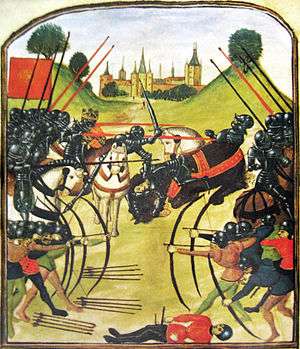George Browne (died 1483)
| Sir George Browne | |
|---|---|
| Spouse(s) | Elizabeth Paston |
|
Issue
| |
| Father | Sir Thomas Browne |
| Mother | Eleanor Arundel |
| Born | 1440 |
| Died |
4 December 1483 Tower of London |
| Buried | Blackfriars, London |
Sir George Browne (1440 – 4 December 1483) was the eldest surviving son and heir of Sir Thomas Browne, beheaded 20 July 1460. He took part in Buckingham's rebellion, and was beheaded on Tower Hill on 4 December 1483.
Family
George Browne was the second but eldest surviving son of Sir Thomas Browne of Betchworth Castle, Surrey, and Eleanor Arundel, the daughter of Sir Thomas Arundel and Joan Moyne, daughter of Henry Moyne. By his mother's first marriage, he had six brothers, including Sir Anthony Browne,[1] and two sisters. After his father's death, his mother married Sir Thomas Vaughan (executed at Pontefract on 23 June 1483).[2]
Career

On 30 September 1460, two months after his father's execution, Browne was granted a pardon by the Yorkists, and in 1470 was arrested with George Plantagenet, 1st Duke of Clarence, and Richard Neville, 16th Earl of Warwick. He fought at the Battle of Tewkesbury on 4 May 1471, and was knighted after the battle by the Duke of Clarence.[1]
He was elected a Member of Parliament for Guildford in 1472 and for Canterbury in 1483. In 1478 he was Knight of the Shire for Surrey, and in 1480 Sheriff of Kent.[1]
In 1472, he surrendered his title and the Manor of Tong to Cecily Neville, Duchess of York.[3]
An undated letter in Browne's hand to John Paston, esquire, containing the cryptic message 'It shall never come out for me', survives among the Paston letters.[4][5]
By 1483 he had switched his allegiance to the future Henry VII, and with a force in Kent took part in the rebellion by Henry Stafford, 2nd Duke of Buckingham, against Richard III. According to Speed:[6]
Another commotion at the same time was in Kent, where George Browne and John Guildford, knights, Fogge, Scot, Clifford and Bonting, with five thousand men attempted great matters at Gravesend, but hearing of the Duke of Buckingham’s surprise, dispersed themselves for that time....whereupon those that lately fled England were indicted of treason, and other of Henry’s factions beheaded, whereof Sir George Browne and Sir Roger Clifford, knights, with four others were beheaded at London, and at Exeter for the like cause died Sir Thomas Sentleger, who had married Lady Anne, Duchess of Exeter, King Richard’s own sister, with others, so jealous was the king of his usurped crown.
Browne was beheaded on Tower Hill on 4 December 1483, and buried at the Blackfriars, London. His widow left a will, proved 26 June 1488, in which she asked to be buried at the Blackfriars with her husband.[1]
Marriage and issue
In 1471 Browne married Elizabeth Paston (1 July 1429 – 1 February 1488), widow of Sir Robert Poynings (slain at the Second Battle of St Albans on 17 February 1461), and daughter of William Paston, Justice of the Common Pleas, and Agnes Berry. By her first marriage she had an only son, Sir Edward Poynings.[7][1][8][9][10]
By Elizabeth Paston, Browne had two sons and a daughter:[11]
- Sir Matthew Browne (d. 6 August 1557), who married Frideswide Guildford, daughter of Richard Guildford, by whom he had eight sons and six daughters.
- George Browne.
- Mary Browne, who married a husband surnamed Bradbridge (or Benbridge).
Notes
- 1 2 3 4 5 Richardson I 2011, p. 340.
- ↑ Richardson I 2011, pp. 338-9.
- ↑ Hasted, Edward (1798). "Parishes". The History and Topographical Survey of the County of Kent. Institute of Historical Research. 6: 132–143. Retrieved 3 April 2014.
- ↑ Davis, Beadle & Richmond 2004, p. 443.
- ↑ Hanham, Alison, 'A Rebel Manifesto of 1483'; A re-examination of the mysterious message that Sir George Browne sent to John Paston III, The Ricardian, Vol. XX, 2010 Retrieved 21 September 2013.
- ↑ Speed 1623, p. 943.
- ↑ Davis 1971, p. lvii.
- ↑ West 2004, p. 39.
- ↑ Richmond 2004.
- ↑ Poynings, Sir Edward (1459-1521), of Westenhanger, Kent, History of Parliament Retrieved 21 September 2013.
- ↑ Richardson I 2011, pp. 340-1.
References
- Davis, Norman, ed. (1971). The Paston Letters and Papers of the Fifteenth Century, Part I. Oxford: Clarendon Press. Retrieved 21 September 2013.
- Davis, Norman; Beadle, Robert; Richmond, Colin., eds. (2004). The Paston Letters and Papers of the Fifteenth Century, Part 2. Oxford: Oxford University Press. Retrieved 21 September 2013.
- Richardson, Douglas (2011). Everingham, Kimball G., ed. Magna Carta Ancestry: A Study in Colonial and Medieval Families. I (2nd ed.). Salt Lake City. ISBN 1449966373.
- Richmond, Colin (2004). "Paston family (per. c.1420–1504)". Oxford Dictionary of National Biography (online ed.). Oxford University Press. doi:10.1093/ref:odnb/52791. (Subscription or UK public library membership required.)
- Speed, John (1623). The Historie of Great Britaine under the Conquests of the Romans, Saxons, Danes and Normans. London: John Beale. Retrieved 21 September 2013.
- West, Diane, trans. (2004). The Paston Women. Woodbridge, Suffolk: D.S. Brewer. Retrieved 21 September 2013.
External links
- David Nash Ford’s Royal Berkshire History: Buckingham’s Insurrection at Newbury Retrieved 21 September 2013
- Confirmed executions at the Tower of London Retrieved 21 September 2013
- Will of Dame Elisabeth Browne, Widow of Blackfriars, City of London, proved 26 June 1488, PROB 11/8/210, National Archives Retrieved 21 September 2013